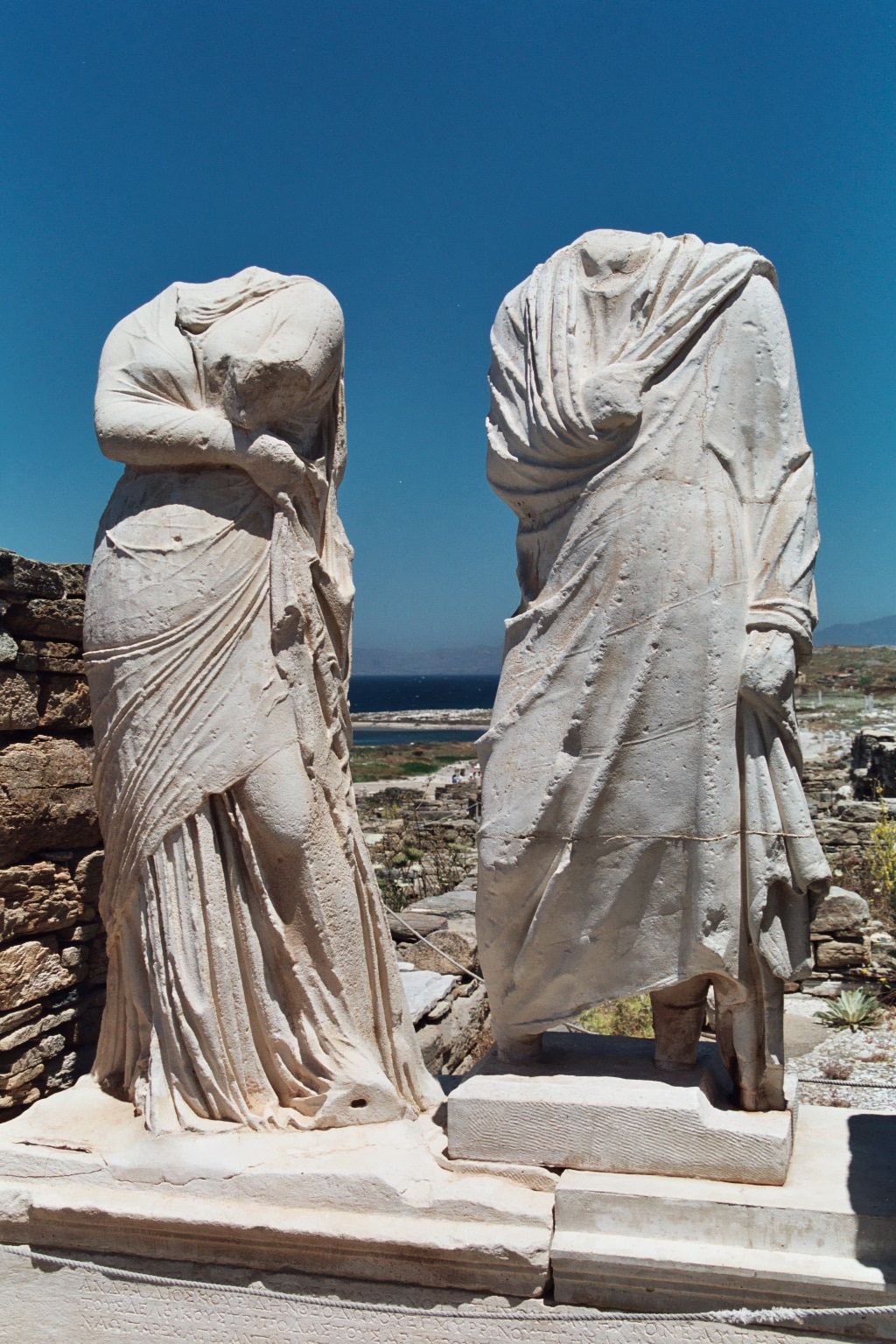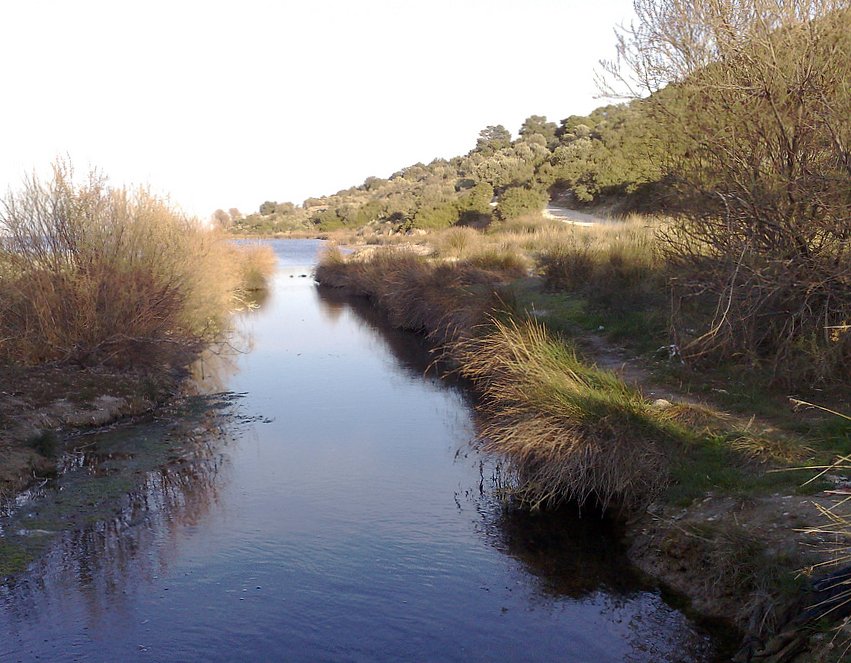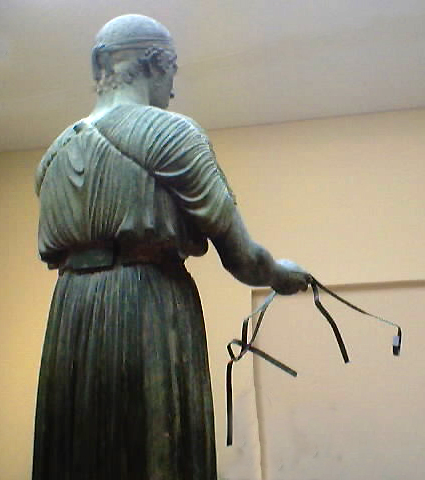|
Enkyklon
Enkyklon was a kind of himation. Enkyklon was most likely used as a wraparound outer garment, a mantle or 'encircling'. It was worn by ancient Greek women from the archaic through the Hellenistic periods. The garment has been recorded at the ancient Greek sanctuary of Artemis, Brauron. Contemporary wraps such as Ampechonon, Epiblēma are also included in the inventories at Delos (Leto, Hera), Brauron, Tanagra and Samos (Hera). See also * Chiton (garment) *Toga The toga (, ), a distinctive garment of ancient Rome, was a roughly semicircular cloth, between in length, draped over the shoulders and around the body. It was usually woven from white wool, and was worn over a tunic. In Roman historical tra ... References {{Historical clothing, state=expanded Greek clothing ... [...More Info...] [...Related Items...] OR: [Wikipedia] [Google] [Baidu] |
Toga
The toga (, ), a distinctive garment of ancient Rome, was a roughly semicircular cloth, between in length, draped over the shoulders and around the body. It was usually woven from white wool, and was worn over a tunic. In Roman historical tradition, it is said to have been the favored dress of Romulus, Rome's founder; it was also thought to have originally been worn by both sexes, and by the citizen-military. As Roman women gradually adopted the stola, the toga was recognized as formal wear for male Roman citizens. Women engaged in prostitution might have provided the main exception to this rule.. The type of toga worn reflected a citizen's rank in the civil hierarchy. Various laws and customs restricted its use to citizens, who were required to wear it for public festivals and civic duties. From its probable beginnings as a simple, practical work-garment, the toga became more voluminous, complex, and costly, increasingly unsuited to anything but formal and ceremonial use ... [...More Info...] [...Related Items...] OR: [Wikipedia] [Google] [Baidu] |
Himation
A himation ( grc, ἱμάτιον ) was a type of clothing, a mantle or wrap worn by ancient Greek men and women from the Archaic through the Hellenistic periods (c. 750–30 BC). It was usually worn over a chiton and/or peplos, but was made of heavier drape and played the role of a cloak or shawl. When the himation was used alone, without a chiton, and served both as a chiton and as a cloak, it was called an ''achiton''. The himation was markedly less voluminous than the Roman toga. It was usually a large rectangular piece of woollen cloth. Many vase paintings depict women wearing a himation as a veil covering their faces. The himation continued into the Byzantine era as "iconographic dress" used in art and by the lower classes, worn by Christ, the Virgin Mary, and biblical figures. Wearing styles Himation is not kept in place using pins, unlike other types of Ancient Greek overgarments. When worn by men, the himation is draped over the left shoulder and wrapped aro ... [...More Info...] [...Related Items...] OR: [Wikipedia] [Google] [Baidu] |
Ancient Greek
Ancient Greek includes the forms of the Greek language used in ancient Greece and the ancient world from around 1500 BC to 300 BC. It is often roughly divided into the following periods: Mycenaean Greek (), Dark Ages (), the Archaic period (), and the Classical period (). Ancient Greek was the language of Homer and of fifth-century Athenian historians, playwrights, and philosophers. It has contributed many words to English vocabulary and has been a standard subject of study in educational institutions of the Western world since the Renaissance. This article primarily contains information about the Epic and Classical periods of the language. From the Hellenistic period (), Ancient Greek was followed by Koine Greek, which is regarded as a separate historical stage, although its earliest form closely resembles Attic Greek and its latest form approaches Medieval Greek. There were several regional dialects of Ancient Greek, of which Attic Greek developed into Koi ... [...More Info...] [...Related Items...] OR: [Wikipedia] [Google] [Baidu] |
Hellenistic Period
In Classical antiquity, the Hellenistic period covers the time in Mediterranean history after Classical Greece, between the death of Alexander the Great in 323 BC and the emergence of the Roman Empire, as signified by the Battle of Actium in 31 BC and the conquest of Ptolemaic Egypt the following year. The Ancient Greek word ''Hellas'' (, ''Hellás'') was gradually recognized as the name for Greece, from which the word ''Hellenistic'' was derived. "Hellenistic" is distinguished from "Hellenic" in that the latter refers to Greece itself, while the former encompasses all ancient territories under Greek influence, in particular the East after the conquests of Alexander the Great. After the Macedonian invasion of the Achaemenid Empire in 330 BC and its disintegration shortly after, the Hellenistic kingdoms were established throughout south-west Asia ( Seleucid Empire, Kingdom of Pergamon), north-east Africa ( Ptolemaic Kingdom) and South Asia ( Greco-Bactrian Kingdom, Indo-Gree ... [...More Info...] [...Related Items...] OR: [Wikipedia] [Google] [Baidu] |
Brauron
Brauron (; grc, Βραυρών) was one of the twelve cities of ancient Attica, but never mentioned as a ''deme'', though it continued to exist down to the latest times. It was situated on or near the eastern coast of Attica, between Steiria and Halae Araphenides, near the river Erasinus. Brauron is celebrated on account of the worship of Artemis Brauronia, in whose honour a festival was celebrated in this place. The sanctuary of Artemis at Brauron (Modern Greek: Βραυρώνα - ''Vravrona'') is an early sacred site on the eastern coast of Attica near the Aegean Sea in a small inlet. The inlet has silted up since ancient times, pushing the current shoreline farther from the site. A nearby hill, c. 24 m high and 220 m to the southeast, was inhabited during the Neolithic era, c. 2000 BCE, and flourished particularly from Middle Helladic to early Mycenaean times (2000–1600 BCE) as a fortified site (acropolis).Hellenic Ministry of Culture Occupation ceased ... [...More Info...] [...Related Items...] OR: [Wikipedia] [Google] [Baidu] |
Chiton (garment)
A chiton (Greek: χιτών, ''khitōn'') is a form of tunic that fastens at the shoulder, worn by men and women of ancient Greece and Rome. There are two forms of chiton. One is the Doric chiton and the later Ionic chiton. According to Herodotus, popular legend was that Athenian women began to wear the chiton as opposed to the peplos after several women stabbed a messenger to death with the bronze pins characteristic of the peplos. Etymology The word ''chiton'' is derived from a Central Semitic language *''kittan'' (e.g. Hebrew כֻּתֹּנֶת ''kuttṓnĕṯ''), ultimately from a word for flax. Different forms and wearing styles A shorter version of the chiton was called the chitoniskos. Doric chiton The Doric chiton is a single rectangle of woolen or linen fabric. It can be worn plain or with an overfold called an ''apoptygma'', which is more common to women. It can be draped and fastened at the shoulder by pins (Greek: peronai; Latin: fibulae) or sewing, or by butto ... [...More Info...] [...Related Items...] OR: [Wikipedia] [Google] [Baidu] |




